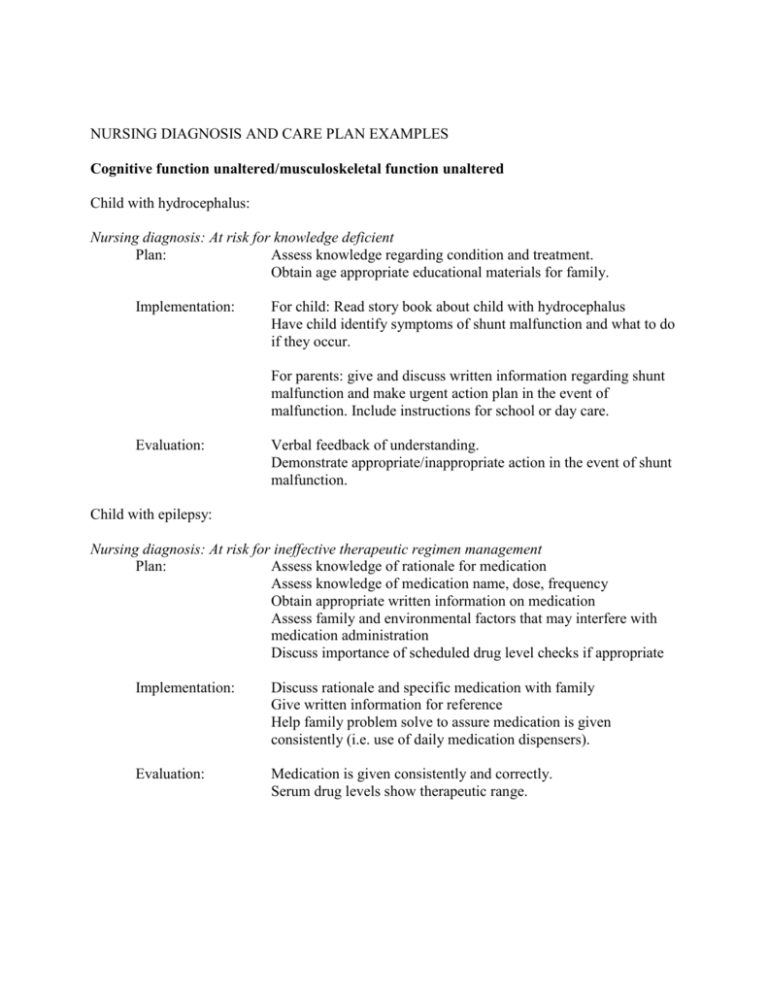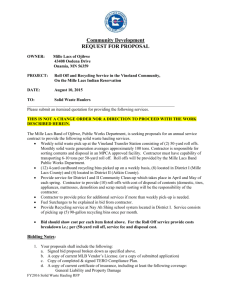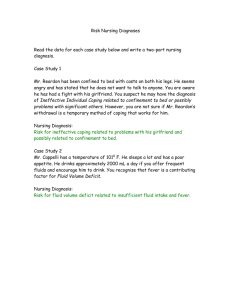Chapter 6 Care Plan
advertisement

NURSING DIAGNOSIS AND CARE PLAN EXAMPLES Cognitive function unaltered/musculoskeletal function unaltered Child with hydrocephalus: Nursing diagnosis: At risk for knowledge deficient Plan: Assess knowledge regarding condition and treatment. Obtain age appropriate educational materials for family. Implementation: For child: Read story book about child with hydrocephalus Have child identify symptoms of shunt malfunction and what to do if they occur. For parents: give and discuss written information regarding shunt malfunction and make urgent action plan in the event of malfunction. Include instructions for school or day care. Evaluation: Verbal feedback of understanding. Demonstrate appropriate/inappropriate action in the event of shunt malfunction. Child with epilepsy: Nursing diagnosis: At risk for ineffective therapeutic regimen management Plan: Assess knowledge of rationale for medication Assess knowledge of medication name, dose, frequency Obtain appropriate written information on medication Assess family and environmental factors that may interfere with medication administration Discuss importance of scheduled drug level checks if appropriate Implementation: Discuss rationale and specific medication with family Give written information for reference Help family problem solve to assure medication is given consistently (i.e. use of daily medication dispensers). Evaluation: Medication is given consistently and correctly. Serum drug levels show therapeutic range. Cognitive function unaltered/musculoskeletal function altered Child with spinal cord injury Nursing Diagnosis: At risk for autonomic dysreflexia Plan: Assess knowledge of autonomic dysreflexia Determine history of occurrences and severity Obtain written plan for managing events Implementation: Problem solve with family to avoid stimuli that contribute to onset of dysreflexia (i.e. catheterize every 4 hours during the day to avoid over distention of bladder). Discuss measures that are needed immediately at onset of symptoms. Evaluation: Track occurrences and severity of events. Child with total body cerebral palsy, non-verbal Nursing Diagnosis: Impaired verbal communication Plan: Assess current non-verbal ways of communicating with others Determine funding sources for child Determine current therapy Implementation: Discuss augmentative communication with family Obtain documentation needed to obtain desired technology Refer to therapist for skill training Help family engage school support for use in education Evaluation: Feedback from child, family and school. Cognitive function altered/musculoskeletal function unaltered Child with severe epilepsy and developmental delay Nursing Diagnosis: self-care deficient- toileting Plan: Assess current skills for toileting Discuss basic principles of toilet training for the developmentally delayed child with family. Implementation: Set small goals for participation in toileting Structure environment to facilitate success (i.e. providing an adaptive toilet seat or tin can for urinating). Use doll play to practice skill with child Communicate with school for consistency. Evaluation: Decrease in accidents, cooperation with training Child with traumatic brain injury with aggressive behavior Nursing Diagnosis: At risk for injury Plan: Discuss nature of events and frequency with family. Assess environment for possible hazards. Implementation: Partner with family to remove hazards from home. Identify specific measures that calm child (i.e. object that soothes child such as stuffed animal or blanket) Identify with family triggers for outbursts. Offer alternative outlets for child (i.e. punching bag) Evaluation: Frequency and intensity of events. Child’s ability to self modulate Injury sustained by child. Cognitive function altered/musculoskeletal function altered Child with thoracic level spina bifida and severe learning disability Nursing Diagnosis: self care deficient-dressing and grooming Plan: Assess current ability to dress and groom self Identify with family one or two realistic goals Implementation: Break down goal into small steps Use multiple teaching methods with child (i.e. video, demonstration, verbal cueing, doll play) Build skill, one step at a time Consult OT if needed Partner with family for specific practice Give short term rewards Evaluation: Achievement of goals Progress toward achievement of goal Child with total body cerebral palsy and severe developmental delay Nursing Diagnosis: Caregiver role stress Plan: Assess family and social support Assess coping of caregiver for stress Implementation: Assist family in application for respite care. Encourage caregiver to participate in support group. Assist family in utilizing community resources for help Evaluation: Feedback from caregiver Case Study/ Care Plan for a Traumatic Injuried Child Mille is a 4 year old girl who received a severe traumatic brain injury when traveling with her grandmother 4 months ago. She was in an automobile in the front seat with her seat belt unbuckled when another automobile hit the grandmother’s car head on, killing Mille’s grandmother and seriously injuring Mille. Mille had an extended hospitalization at a tertiary care center that she was airlifted to approximately 35 miles from her home. She then spent an additional 10 weeks in a large Rehabilitation center 40 miles from her home. She was discharged 5 days ago and has been home a brief time. Mille is dependent on a gastrostomy tube for all of her hydration and nutrition. In addition to the g tube she has a tracheostomy, oxygen for night time support. She also suffers from general clonic tonic seizures that occur approximately 1-2 times per week, despite medication management. Mother was taught to manage the g-tube , trach care in the last portion of Mille’s rehabilitation stay. Upon beginning Mille’s care this morning, her mother discovers that Mille’s g-tube is out and laying beside her in bed. She does not know how long it has been this way but becomes very panicked and calls the Emergency Medical personel near her home and Mille is transported to the local ER. Mille is stable on arrival with hypertonia and contractions in all extremeties. Her mother breaks down in the ER exam room, crying and unconsolable. What interventions need to take place and what are some of the concerns about this neurologically impaired child and family? Assessment/Discussion: Mille’s stable state reveal that her tracheostomy tube is in place, breathing and circulation were all intact. Her BP was 120.70. Neurologically Mille was stable with no seizure activity. The g tube was indeed out. The g-tube was replaced per hospital personel after consulting the GI and Neurological specialists from the original tertiary care center. Her morning medications and feeding were given immediately and were delayed for approximately 1 hour. A wide range of disabilities can result from a traumatic brain injury. Mille was totally dependent on her feeding tube for hydration, nutrition, and medications. Because of this, reinstating the g-tube was of high priority for Mille, for her overall health including her neurological status. Parents of children with special needs are commonly very expert in the cares needed for their child. Mille had not been home for a long period of time. Parents were still in the transition period when the g tube fell out. Mille’s mother was extremely anxious and panicked when she arrived to the ER. Her “break down” and unconsolable crying prompt health care professionals to note whether she, as the prime care giver was exhausted and to question whether mother was able to receive enough rest herself to have the energy to receive care. It was found Mille was on a waiting list for Nursing to come to her home for 8 hours each day to give mother a “break” and assist with the around the clock care. After assessment, a discussion with social work, the nurse in the ER and her child’s pediatrician helped to put more support in place in the next 24 hours with the assistance of her community church, and extended family. Care needs for Mille were reviewed with her mother and father, an extended family member (Aunt) and church member . The latter two verbalized interest in assisting to “relieve” Mille’s mother/father periodically to give them a needed rest. Mille’s mother was also given a phone support group of mothers who had a child with a traumatic injury to use as she felt needed. A local home health agency visited 3 times a week to check on the family, plan for care, and how the family was coping until the state nursing program was able to be obtained and 8 hours of nursing care obtained per day. S








